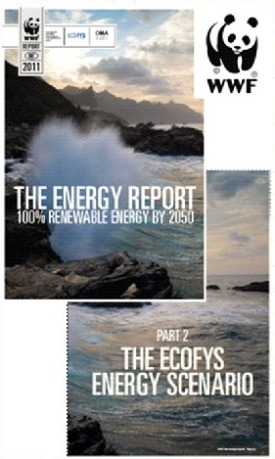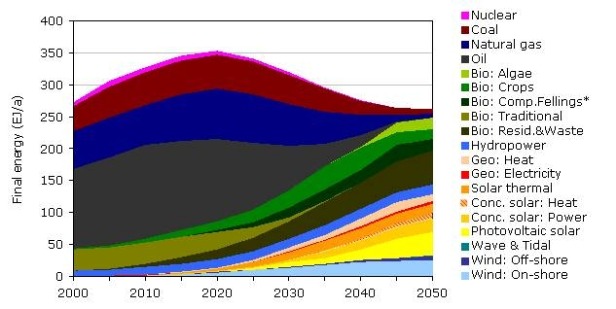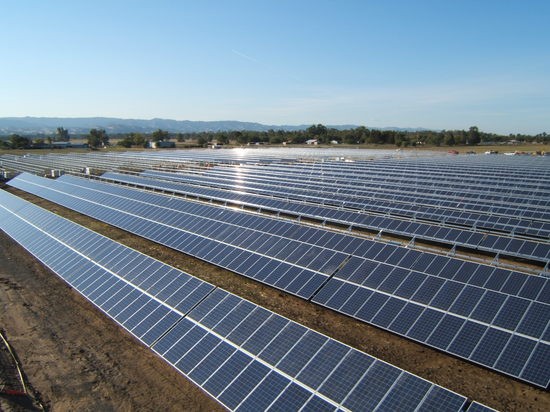 There are many reasons to move to a sustainable energy system: fossil fuel supplies getting tighter, easy oil increasingly having to be replaced by uneasy oil, accelerating climate change. And most indications are that we’ll have to go there as soon as possible.
There are many reasons to move to a sustainable energy system: fossil fuel supplies getting tighter, easy oil increasingly having to be replaced by uneasy oil, accelerating climate change. And most indications are that we’ll have to go there as soon as possible.
But is it possible? And when? At Ecofys, we’ve been working for 25 years on our mission: “a sustainable energy supply for everyone.” Two years ago, we figured it was about time to bring all our experts together to find out whether that really makes sense. Excited by our first findings, we found WWF willing to commission an in-depth study. And since today, the word is out! Or actually, 250 pages of it, in what’s now called “The Energy Report.” And the good news is: it’s possible indeed, by 2050.
We started out by charting expected developments (population, economy) in 10 world regions. Global tempering of consumption is an easy way out for a scenario builder, but not very acceptable in the real world. And trying to keep up with the present growth in energy demand makes catching up with renewables practically impossible. So we went for maximum materials and energy efficiency, and looked for all available ways to provide the rising demand for services and goods with as little input of energy as possible. And there’s a huge potential out there, given the fact that 95 percent of present energy consumption is waste, if one really looks at the end service provided (such as useful light).
Applying all those measures in industrial processes, buildings, and transport, and taking into account feasible implementation rates, leads to global energy demand stabilizing around 2020, and then slowly going down to just below 2000 levels, in spite of economic activity tripling by 2050.

When going over the renewable options available to supply that energy, one finds that the real bottleneck is in the fuels part of demand. Unless we can move to new fuels (like hydrogen) on a massive scale, which we did not consider likely for this period, much of that will have to come from biofuels. And for biofuels, we have to be very strict on avoiding competition with food production, dependence on irrigation (aggravating water supply problems), and destruction of forests.
So it makes a lot of sense to focus on electrification first: urban transport can be moved from fuel to electricity, and so can a lot of domestic heat demand. After stringent insulation of the home, and a solar heater for domestic hot water, an electric heatpump can be an efficient source for the remaining heat demand. These measures, combined with a strong growth in (energy efficient) appliances, lead to a growing fraction of electricity, for which a host of renewable options is available, like wind, solar, and geothermal power. Of course we’ll need smart grids to accommodate a growing fraction of supply-driven sources; 25 percent is no problem in present grids, but we’ll need to go to 60 percent by 2050.
After that, bio-energy comes into play, especially for fuels in shipping and aviation. Here we start with maximizing the use of residues from the forest and field, the food industry, and household waste. Then we introduce a limited amount of bio-crops, applying strict sustainability criteria. In the meantime, we phase out traditional biomass that is now used for cooking, often unsustainable. And from 2030, biomass from algae enters the scene: technology is available now, but needs to go a long way to become cost-competitive.
The resulting development looks like this:

If you watch the graph closely, you will see that we’ve actually found 95 percent of the solution. The remaining part is in processes for which we found no suitable renewable technologies available now. But hey, it’s only 2011! Continued strong technological development can be expected in the decades to come.
Economically, following this road means that the world needs to divert up to 3 percent of GDP to investments in materials and energy efficiency, renewable energy, and necessary infrastructure. But savings on fossil fuels grow larger year by year, and the net cash needed peaks at 2 percent of GDP, before turning around into net savings by 2035. In 2050, we’ll leave behind a system with immensely lower operating cost than the “business-as-usual” fossil-based system.
In the meantime, the effort will bring energy-related greenhouse-gas emissions down by 80 percent compared to their 1990 levels, providing a reasonable chance to limit average global warming to below 2 degrees C (3.6 F), as generally deemed necessary. This will obviously have big advantages in avoided climate change damage and adaptation costs.
And it will have a host of other benefits, like reduction of environmental pollution.
So yes, it can be done! What’s necessary is strong leadership from both governments and companies. And hard work by all of us.
The Energy Report can be downloaded (16 MB) here.




